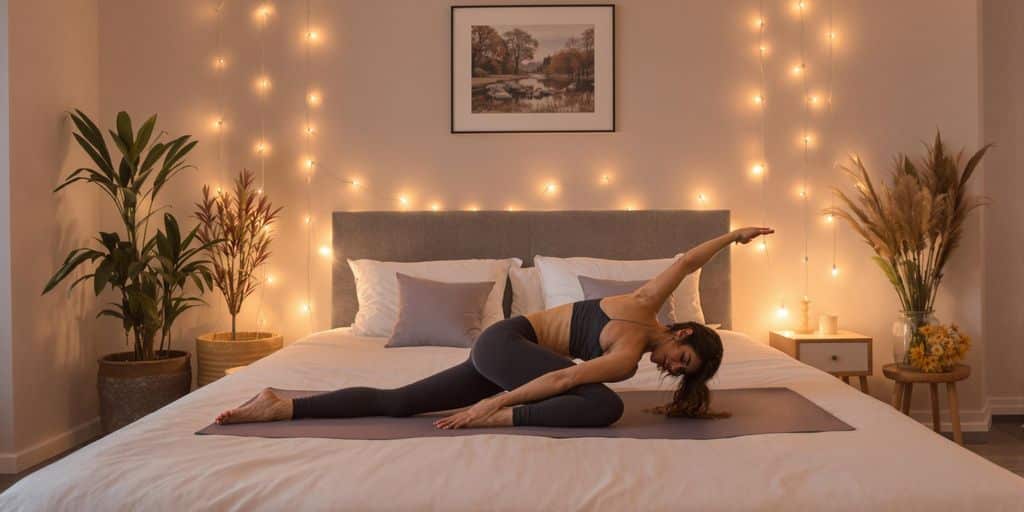Ever heard that working out before bed messes with your sleep? Turns out, that's not entirely true. The right kind of exercise can actually help you relax and prepare your body for a great night's rest. We're not talking about intense cardio or heavy lifting here—this is all about gentle, calming movements that ease your mind and body. Whether you're looking to unwind after a long day or improve your sleep quality, bedtime workouts might be the game-changer you need.
Key Takeaways
- Gentle exercises before bed can reduce stress and help you sleep better.
- High-intensity workouts are best avoided late at night.
- Low-impact activities like yoga or stretching are ideal for relaxation.
- Timing your workout about an hour before bed works best.
- End your routine with stillness or mindfulness to fully relax.
Why Work Outs Before Bed Can Improve Your Sleep
Debunking the Late-Night Exercise Myth
You’ve probably heard it before—working out at night will mess with your sleep. But guess what? That’s not entirely true. In fact, studies suggest that low-intensity evening exercises can actually improve sleep quality. The trick is avoiding high-energy workouts that get your adrenaline pumping. Instead, think of gentle movements that calm your body and mind.
How Gentle Movement Lowers Stress Hormones
Stress is a major sleep killer, and one of the biggest culprits is cortisol, the stress hormone. The good news? Gentle exercises like yoga or stretching can help lower those cortisol levels. Plus, they release endorphins, which are like little mood boosters for your brain. Together, these effects help you feel relaxed and ready to drift off.
The Science Behind Better Sleep Through Exercise
Here’s the deal: when you move your body, you’re not just stretching muscles—you’re signaling to your brain that it’s time to wind down. Low-intensity workouts can even lower your body temperature post-exercise, a key factor in falling asleep faster. This natural cooling effect helps signal your body that it’s time for rest. And when your body’s in sync, you’re more likely to enjoy deep, restorative sleep.
The Best Types of Work Outs Before Bed

Why High-Intensity Workouts Are a No-Go
Let’s get one thing straight: high-intensity workouts, like sprints or HIIT, are not your bedtime buddies. These exercises can spike adrenaline and keep your heart racing long after you’ve finished, making it harder to wind down. Instead, save those energy-boosting moves for earlier in the day. Your nighttime routine should help you relax, not rev you up.
Top Low-Impact Exercises for Relaxation
Low-impact exercises are the way to go when it comes to evening workouts. These activities are gentle on your body and promote relaxation. Here are some great options:
- Stretching: Loosens up tight muscles and improves blood flow, setting the stage for restful sleep.
- Bodyweight Exercises: Think slow, controlled movements like squats or planks. These build strength without overstimulation.
- Somatic Exercises: Techniques like the Bear Hug or Letting Go can help calm your nervous system. Check out somatic exercises designed to enhance sleep quality for more ideas.
How Yoga Prepares Your Body for Rest
Yoga is the ultimate pre-sleep workout. Gentle poses, combined with deep breathing, help release tension and calm your mind. Moves like Child’s Pose or Legs Up the Wall are excellent choices. Plus, yoga encourages mindfulness, which can ease those racing thoughts that often keep you awake. It’s a double win for your body and mind!
The key to a successful bedtime workout is choosing activities that soothe rather than stimulate. Keep it slow, steady, and centered on relaxation.
Crafting Your Perfect Bedtime Workout Routine
Timing Your Workout for Maximum Benefits
When you work out matters just as much as how you work out. Aim to finish your bedtime exercises about 30–60 minutes before you hit the sheets. This gives your body time to cool down and your heart rate to settle. Working out too close to bedtime can leave you feeling wired instead of relaxed, so play around with timing to find what fits your rhythm.
If your evenings are packed, consider starting earlier. A little trial and error can help pinpoint the sweet spot that works best for you.
Creating a Relaxing Environment
Your surroundings can make or break the vibe of your bedtime routine. Dim the lights to signal your brain that it’s time to wind down. Bright lights can mess with your melatonin levels, so opt for warm-toned bulbs or even fairy lights. You can also add calming scents like lavender or chamomile to amplify the chill atmosphere.
Keep the room cool, too. A temperature between 60–67°F is ideal for sleep, and a fan or a damp towel can help if you can’t adjust the thermostat. A cozy yet cool environment sets the stage for a workout that feels more like self-care than a chore.
The Role of Breathing and Mindfulness
Breathing is your secret weapon for relaxation. During your workout, focus on slow, deep breaths to calm your nervous system. Pair this with mindfulness—tuning into how your body feels with each stretch or movement. It’s not just about the physical; it’s about creating a mental state that’s ready for rest.
For a quick and soothing exercise, try Legs Up the Wall. This yoga pose is perfect for calming your mind and easing tension in your body. Just two minutes in this position can work wonders for your pre-sleep vibe.
A bedtime workout isn’t just a chore—it’s your chance to unwind, reset, and set the tone for restful sleep. Take it slow, and make it a ritual you actually look forward to.
Quick and Effective Exercises to Try Tonight

Legs Up the Wall for Instant Calm
This simple pose is like hitting the reset button for your body and mind. It’s perfect if you’re feeling stressed or restless before bed. Here’s how to do it:
- Sit sideways next to a wall and carefully swing your legs up while lying on your back.
- Rest your arms at your sides and let your feet relax against the wall.
- Stay in this position for about 2 minutes, focusing on slow, deep breaths.
Pro Tip: Place a folded blanket or pillow under your hips for extra comfort and to enhance relaxation. This can also improve blood flow.
Gentle Stretches to Release Tension
Stretching is a fantastic way to loosen up tight muscles and encourage blood flow, helping you wind down. Try these moves:
- Child’s Pose: Kneel on the floor, sit back on your heels, and stretch your arms forward. Hold for 30 seconds.
- Cat-Cow Stretch: On all fours, alternate between arching your back and rounding it, syncing the movements with your breath.
- Seated Forward Fold: Sit with your legs extended, reach for your toes, and hold for 20–30 seconds. Don’t worry about touching them—just go as far as feels comfortable.
Bodyweight Moves for Full-Body Relaxation
Light bodyweight exercises can help you release any lingering physical tension. Here are a couple of easy options:
- Table Top: Sit with your knees bent and hands behind you. Lift your hips to form a table shape, hold for 5 breaths, then lower. Repeat 3 times.
- Elevated Lunges: Place one foot on a low surface (like a step) and sink into a lunge. Alternate legs for 2 minutes.
A short bedtime routine doesn’t need to be complicated. These exercises are designed to calm your body and mind, setting the stage for a peaceful night’s sleep.
For more ideas on relaxing bedtime techniques, check out effective exercises to perform before bedtime that focus on easing tension and improving sleep quality.
Tips to Make Your Bedtime Workouts More Effective
Hydration Without Overdoing It
Staying hydrated is important, but there’s a fine line when it comes to bedtime workouts. Sip water to refresh yourself, but avoid chugging large amounts right before bed. Overhydrating can lead to those annoying late-night bathroom trips that disrupt your sleep. If you tend to get thirsty, try drinking more water earlier in the evening to "prehydrate" and keep your nighttime intake minimal.
Using Lighting to Signal Relaxation
Lighting is key to setting the right mood for a bedtime workout. Bright lights can trick your brain into thinking it’s still daytime, which messes with melatonin production. Instead, dim the lights in your workout space. Use warm-toned bulbs, fairy lights, or even candles for a cozy, calming vibe. Pair this with a soothing scent, like lavender, to really signal your body it’s time to wind down.
Ending Your Routine with Stillness
The way you finish your workout can make or break your transition to sleep. After your last stretch or movement, take a moment to sit or lie still. Focus on your breathing—deep inhales and slow exhales. This final moment of stillness helps your body fully shift into relaxation mode. Think of it as the cherry on top of your bedtime routine.
Common Mistakes to Avoid in Bedtime Workouts
Skipping the Cool-Down Phase
One of the biggest mistakes people make is rushing through their workout and skipping the cool-down. This part is essential because it helps your heart rate and breathing return to normal. Plus, it signals to your body that it's time to relax. Skipping this step can leave you feeling restless instead of ready for bed. Make time for some light stretches or deep breathing exercises to wind things down properly.
Choosing the Wrong Type of Exercise
Not all workouts are created equal, especially when it comes to bedtime. High-intensity exercises like sprints or heavy weightlifting can spike your adrenaline and make it harder to fall asleep. Instead, stick to low-impact activities like yoga, stretching, or gentle bodyweight movements. These help calm your nervous system and prepare you for a restful night.
Overhydrating Before Sleep
Hydration is important, but drinking too much water right before bed can lead to frequent bathroom trips that disrupt your sleep. Aim to sip water moderately during your workout and stop drinking large amounts at least an hour before bedtime. If you often feel thirsty at night, try hydrating earlier in the evening to avoid overdoing it later.
Wrapping It All Up
So there you have it—adding a simple bedtime workout to your routine can really change the way you sleep. It’s not about going all out or breaking a sweat; it’s about easing into the night with gentle movements that calm your body and mind. Whether it’s a few stretches, some light yoga, or just a couple of minutes with your legs up the wall, these small steps can make a big difference. Give it a try tonight—you might just wake up feeling more refreshed and ready to take on the day. Sweet dreams!
Frequently Asked Questions
Is it okay to exercise before going to bed?
Yes, exercising before bed can actually improve sleep quality if done correctly. Gentle, low-intensity movements help relax your body and mind, getting you ready for restful sleep.
What types of exercises are best for a bedtime routine?
Low-impact exercises like yoga, stretching, or light bodyweight moves are ideal. These activities calm your body without overstimulating it, making it easier to wind down.
Should I avoid high-intensity workouts at night?
Yes, high-intensity workouts can raise your heart rate and adrenaline levels, making it harder to relax and fall asleep. Save these for earlier in the day.
How long before bed should I finish my workout?
It's best to complete your workout 30–60 minutes before bedtime. This allows your body to cool down and transition into a relaxed state.
How can I make my bedtime workout more effective?
Create a calming environment with dim lighting, soothing music, and a cool room temperature. Focus on deep breathing and mindfulness during your exercises.
What are common mistakes to avoid in bedtime workouts?
Avoid skipping the cool-down phase, overhydrating, or choosing high-intensity exercises. These can disrupt your ability to relax and get a good night’s sleep.

